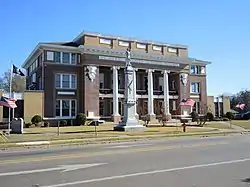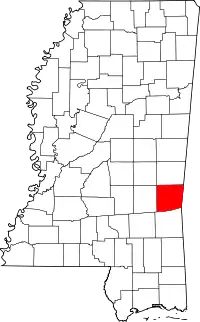Quitman, Mississippi
Quitman is a city in Clarke County, Mississippi, United States, along the Chickasawhay River. The population was 2,323 at the 2010 census.[3] Quitman is the county seat of Clarke County.[4][5]
Quitman, Mississippi | |
|---|---|
 Clarke County Courthouse and Confederate monument in Quitman | |
 Seal | |
| Motto: "A Very Special Place To Call Home"[1] | |
 Location of Quitman, Mississippi | |
 Quitman, Mississippi Location in the United States | |
| Coordinates: 32°2′35″N 88°43′15″W | |
| Country | United States |
| State | Mississippi |
| County | Clarke |
| Area | |
| • Total | 5.90 sq mi (15.29 km2) |
| • Land | 5.18 sq mi (13.41 km2) |
| • Water | 0.73 sq mi (1.88 km2) |
| Elevation | 230 ft (70 m) |
| Population (2020) | |
| • Total | 2,061 |
| • Density | 398.11/sq mi (153.71/km2) |
| Time zone | UTC-6 (Central (CST)) |
| • Summer (DST) | UTC-5 (CDT) |
| ZIP code | 39355 |
| Area code | 601 |
| FIPS code | 28-60720 |
| GNIS feature ID | 0676438 |
| Website | www |
History
Quitman was established in 1839 and named as the county seat.[1]
During the Civil War, a hospital built with funds raised in Galveston and Houston, among other places, was built there for the care of Confederate soldiers from Texas. Originally staffed by Louis Bryan with supplies purchased in Mexico, he was joined, and later supplanted, by Enos Bonney, a surgeon from Enterprise, Mississippi, who stayed until the hospital was burned down. Though it cared for troops from any state, the hospital was colloquially known as "The Texas Hospital." Wounded soldiers from the Second Battle of Corinth, Battle of Iuka, Battle of Jackson, Tennessee, and more local engagements, as well as those suffering from wartime diseases, were treated at the hospital. A cemetery was established adjacent to the hospital for those who succumbed to disease or wounds.
During General Sherman's Meridian Campaign, Brigadier General Walter Q. Gresham, Commander of the Third Brigade, Fourth Division, 17th Army Corps, was detached and sent to Quitman to destroy bridges crossing the Chickasawhay river and through Alligator Swamp, as well as any other infrastructure that could be of any use to the Confederacy.[6] The force arrived at Quitman and proceeded to burn the town jail, courthouse, various stores, the railroad depot, and the Methodist Church, which was being used as a hospital.[7] Troops then burned down the entire Texas Hospital complex, which included two main buildings as well as twelve to fifteen barracks. The hospital was never rebuilt.[8][9][10]
Quitman was officially recognized by the Mississippi Legislature on February 13, 1839, and was named for the second Chancellor of the State, Gen. John A. Quitman, a strongly pro-slavery politician, leading Fire Eater, veteran of the Mexican–American War.[11]
Geography
Quitman is located near the center of Clarke County. Mississippi Highway 18 passes through the center of the city.
According to the United States Census Bureau, the city has a total area of 5.9 square miles (15.3 km2), of which 5.2 square miles (13.4 km2) is land and 0.73 square miles (1.9 km2), or 12.28%, is water.[3]
Climate
| Climate data for Quitman | |||||||||||||
|---|---|---|---|---|---|---|---|---|---|---|---|---|---|
| Month | Jan | Feb | Mar | Apr | May | Jun | Jul | Aug | Sep | Oct | Nov | Dec | Year |
| Average high °F (°C) | 56.6 (13.7) |
62.0 (16.7) |
69.2 (20.7) |
77.5 (25.3) |
83.9 (28.8) |
89.7 (32.1) |
91.9 (33.3) |
91.5 (33.1) |
87.0 (30.6) |
77.8 (25.4) |
68.6 (20.3) |
60.0 (15.6) |
76.3 (24.6) |
| Average low °F (°C) | 32.9 (0.5) |
36.1 (2.3) |
42.6 (5.9) |
50.3 (10.2) |
58.2 (14.6) |
65.1 (18.4) |
68.5 (20.3) |
67.6 (19.8) |
62.3 (16.8) |
49.2 (9.6) |
41.6 (5.3) |
35.4 (1.9) |
50.8 (10.4) |
| Average precipitation inches (mm) | 5.5 (140) |
4.9 (120) |
6.1 (150) |
5.3 (130) |
4.0 (100) |
4.0 (100) |
5.1 (130) |
3.5 (89) |
3.8 (97) |
3.2 (81) |
4.0 (100) |
5.3 (130) |
54.8 (1,390) |
| Source: Weatherbase [12] | |||||||||||||
Demographics
| Census | Pop. | Note | %± |
|---|---|---|---|
| 1880 | 410 | — | |
| 1890 | 395 | −3.7% | |
| 1900 | 498 | 26.1% | |
| 1910 | 950 | 90.8% | |
| 1920 | 1,375 | 44.7% | |
| 1930 | 1,872 | 36.1% | |
| 1940 | 1,471 | −21.4% | |
| 1950 | 1,817 | 23.5% | |
| 1960 | 2,030 | 11.7% | |
| 1970 | 2,702 | 33.1% | |
| 1980 | 2,632 | −2.6% | |
| 1990 | 2,736 | 4.0% | |
| 2000 | 2,463 | −10.0% | |
| 2010 | 2,323 | −5.7% | |
| 2020 | 2,061 | −11.3% | |
| U.S. Decennial Census[13] | |||
| Race | Num. | Perc. |
|---|---|---|
| White | 1,189 | 57.69% |
| Black or African American | 759 | 36.83% |
| Native American | 9 | 0.44% |
| Asian | 4 | 0.19% |
| Pacific Islander | 2 | 0.01% |
| Other/Mixed | 72 | 3.49% |
| Hispanic or Latino | 28 | 1.36% |
As of the 2020 United States census, there were 2,061 people, 897 households, and 619 families residing in the city.
Education
The city is served by the Quitman School District.[15][16]
Notable people
- Andy Blakeney, jazz trumpeter[17]
- Wyatt Emory Cooper, writer[18]
- Oscar W. Gillespie, U.S. Representative for the state of Texas[19]
- Dustin J. Lee, Corporal in the United States Marine Corps who was killed in Fallujah, Iraq[20]
- Sam C. Massingale, American politician and a U.S. Representative from Oklahoma[21]
- Kelly McCarty, former NBA player[22]
- Antonio McDyess, former NBA power forward [23]
- Tarvarius Moore, NFL defensive back[24]
- Homer Smith, Jr, journalist[25]
- Samuel H. Terral, Justice of the Mississippi Supreme Court from 1897 to 1903[26]
- James Yates (activist), labor organizer, political activist, and veteran of the Spanish Civil War[27]
See also
References
- "The City of Quitman Mississippi". The City of Quitman Mississippi. Archived from the original on October 28, 2012. Retrieved October 10, 2012.
- "2020 U.S. Gazetteer Files". United States Census Bureau. Retrieved July 24, 2022.
- "Geographic Identifiers: 2010 Demographic Profile Data (G001): Quitman city, Mississippi". U.S. Census Bureau, American Factfinder. Archived from the original on February 12, 2020. Retrieved October 6, 2014.
- "Find a County". National Association of Counties. Archived from the original on May 31, 2011. Retrieved June 7, 2011.
- "Profile for Quitman, Mississippi, MS". ePodunk. Archived from the original on June 11, 2016. Retrieved October 10, 2012.
- Sherman's Forgotten Campaign, M. Bearss
- No.33 Report of Brig. General Walter Q. Gresham, Official Records of the War of the Rebellion Volume XXXII/1 p. 247
- Rowland, Dunbar (1978) [1908]. Military History of Mississippi, 1803 - 1898: taken from the Official and statistical register of the State of Mississippi, 1908. Spartanburg, South Carolina: Reprint Co. pp. 494–498. ISBN 978-0871522665.
- Bengston, Wayne C. (May 30, 2003). "The Texas Hospital & Confederate Cemetery Quitman, Mississippi, February 17, 1864". Retrieved July 18, 2021.
- "Confederate Memorial Cemetery in Quitman, MS". Waymarking, Veteran Cemeteries. January 21, 2017. Retrieved July 19, 2021.
- "Quitman". Visit Clarke County. Retrieved June 9, 2020.
- "Weatherbase: Historical Weather for Quitman, Mississippi". Weatherbase. 2011. Retrieved on November 24, 2011.
- "Census of Population and Housing". Census.gov. Retrieved June 4, 2015.
- "Explore Census Data". data.census.gov. Retrieved December 8, 2021.
- "Quitman School District". Quitman School District. Archived from the original on August 26, 2012. Retrieved October 10, 2012.
- "Quitman School District". Great Schools Inc. Retrieved October 10, 2012.
- "Andy Blakeney". AllMusic.com. Retrieved May 17, 2020.
- "Wyatt Cooper". IMDb. Retrieved October 10, 2012.
- Ben R. Guttery (October 2007). Representing Texas. Ben Guttery. p. 68. ISBN 978-1-4196-7884-4.
- Hanks, Nathan L. (March 29, 2012). "Retired military working dog dies". United States Marine Corps. Retrieved May 17, 2020.
- United States. Congress. House. Committee on Resources (2002). Historical Information of the Committee on Resources and Its Predecessor Committees 1807-2002: Preparation for a Bicentennial : Prepared for the Use of the Committee on Resources of the One Hundred Seventh Congress, Second Session. U.S. Government Printing Office. p. 666.
- "Kelly McCarty earns Southern Miss degree after lengthy career in NBA, Israel and Russia". southernmiss.com. University of Southern Mississippi. Retrieved May 17, 2020.
- "Antonio McDyess". Baseball-Reference.Com. Retrieved October 10, 2012.
- Zierlein, Lance. "Tarvarius Moore". NFL.com. National Football League. Retrieved May 17, 2020.
- Simba, Malik. "Homer Smith, Jr. (1909-1972)". blackpast.org. Retrieved May 17, 2020.
- History of Texas, Together with a Biographical History of Milam, Williamson, Bastrop, Travis, Lee and Burleson Counties: Containing a Concise History of the State, with Portraits and Biographies of Prominent Citizens of the Above Named Counties, and Personal Histories of Many of the Early Settlers and Leading Families. Lewis Publishing Company. 1893. p. 400.
- Yates, James. "Biography". Abraham Lincoln Brigade Archives.
